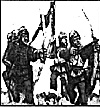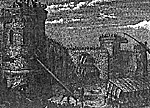 This Sunne of York was designed as a relatively quick wargame strong on period flavour but without the head scratching and multiple tables of various Nth Editions.
This Sunne of York was designed as a relatively quick wargame strong on period flavour but without the head scratching and multiple tables of various Nth Editions.
Contingents & Basing
The medieval army was divided into a number of battels. Each battel was made up of many smaller contingents brought by the Lords and supporters behind each cause. In Sunne of York each 'battel' is created from several bases of model soldiers called 'contingents'.
Each contingent has a base filled with 9-12 figures - yes, - no more zippy little Napoleonic style maneouvres, instead, think big and unwieldy units. I like billmen, so my bases have two lines of billmen behind one rank of archers. Those of you who prefer archers should have two rows of archers instead. But please, use what you already have. If you have billmen and archers on separate bases then combine one of each and that becomes a 'contingent' for the game. This at least allows you to move the archers behind the billmen when it comes down to hand to hand combat. Whatever, each base represents a mix of archers, men-at-arms and billmen. If you can, put a standard bearer in there for effect. A medieval tabletop festooned with bright banners looks terrific and really adds to the flavour of game in hand.
Cavalry should be on the same bases as the foot, two-three horsemen each. Skirmishers are speciality troops, don`t bother with bases, just string out a handful of figures in front of your battle-line (see Skirmishers). Artillery is given a base to itself with one or two guns as you prefer, or again, left unbased.
Ye Noble Commanders
Here`s another departure from professional wargame rules. Both the bases with the individual 'battel' commanders AND the overall army commander are double size - holding between 15 - 20 figures (foot that is, around 5 horse). Again we want the look of big unwieldy formations. The army commander`s base is large as it includes the reserve, though I would suggest keeping it down to 12 figures or so.
Try rallying the line now, once the commander`s double size contingent has disappeared in a blue funk. Similarly, when Warwick or Edward IV shamble off the table, it`s more of a psychological blow to the gamer than watching two mounted knights run off.
All along I`ve been calling these bases - if, like me you are enamoured with the tray idea used in the Lance & Longbow`s POLEAXED late medieval rule system, then use by all means use this method.
Ye Common Soldiery
Knights being all mounted cavalry fitted for shock action
Men at Arms being the battle commander, Knights and the better off on foot with crunching weapons.
Billmen being the bulk of foot armed with two-handed polearms
Pikemen being, well, pikemen
Archers the same, except being archers of course.
Skirmishers being annoying hand-gunners and crossbowmen
Artillery being anything big that goes "BANG !"
Mercenaries Any of the above, who fight for money rather than cause (`cause the Duke'll burn my house down if I don`t come to the muster).
Stragglers & Casualties
I believe that battles from antiquity to the present day are won or lost principally through the effects of disorder and loss of cohesion. This 'friction' is created by the loss of officers, casualties and disorganisation through movement and of course poor morale. Most authorities on battle in the age of the bladed weapon concur that the majority of casualties occurred in the pursuit following the collapse of one side or t`other.
In Sunne of York , friction created by breakdown of cohesion, leadership and morale is represented by model "Stragglers", whilst the dead and the wounded are represented by model "Casualties". These are placed behind the individual contingents as they are incurred through combat or just the simple act of moving.
Each contingent can only take so much friction (casualties and/or stragglers) before it loses heart and flees the battlefield.
Casualties are a permanent loss to the contingent, but stragglers may be recovered in the Rally Phase, as long as they are not moving or involved in hand to hand combat.
I like filling the table up with stragglers and casualties as the game goes on, as the battels really do look like they are beginning to lose cohesion and turn into a rabble. However, if that`s not your bag, use counters such as discarded shields or flags for disorder and weapons casualties.
Battel Morale & Cohesion
We must also consider the overall leadership, morale and cohesion of the battel. This is created by an all in one factor between 5 & 10, called for want of a better name, the "Baldrick" Factor. Think of pip dice in DBM if you like.
How you establish the factor is up to you - I allow one point per X,000 men, + 1 for defenses, + / - 1 or 2 for generalship, (Warwick +1, Edward VI +2) that sort of thing, with seven being a good medium starting point.
The "Baldrick" Factor is best represented physically on the tabletop, rather than with pen an paper as it will fluctuate throughout the course of the game. Use markers, individual Men At Arms or preferably with additional standards.
So how does the Baldrick ('Balders' for short, eh) work ?
A 'Balders' can be used to recover stragglers during the Rally Phase or act as a positive effect on both archery and hand to hand combat by providing doubled efforts from leadership intervention.'Balders' cannot be used for either artillery or skirmishers.
One 'Balders' is lost permenantly for every routed base from the Battel. If the Men At Arms base disappears in a blue funk, so too goes the entire 'Baldrick' Factor. 'Balders' may also be lost to the enemy.
The Rule of Thumb
Mike Clancy knows this one! Another bit of medieval flavour is achieved through doing away with inches and millimetres. Instead we`re going to use the medieval archers` "Rule of Thumb" for all movement and ranges on the tabletop.
 All firing and movement is calculated in "RoTs" (distance between tip of thumb and end of fist by pinky, about 5-6" or so) - abandon here all other measuring devices. But wait a minute, measuring this way isn`t 'accurate' and distances will be variable. Eureka!
All firing and movement is calculated in "RoTs" (distance between tip of thumb and end of fist by pinky, about 5-6" or so) - abandon here all other measuring devices. But wait a minute, measuring this way isn`t 'accurate' and distances will be variable. Eureka!
The Game of Warre
After all that the actual combat is easy!
Rally Phase
Movement Phase : Shooting
Combat Phase : Shooting
Melee
Ye Rally
One 'Balders' may be spent to recover one straggler from any one contingent that is NOT in hand to hand combat. A number of stragglers may be recovered up to total number of 'Balders' held by the battel.
'Balders' are NOT transfereable between battels. The Reserve however, can feed 'Balders' to other battels at a permenant loss to themselves.
'Balders' spent in the Rally Phase may NOT be used during other phases in the turn.
A battle which has no 'balders' at all, cannot advance.
Movement
Rules which give you different movement rates for HI, LHI, MI etc. are all basically flawed. Movement is NOT about how far a man in plate armour can stumble across a muddy field, but how far a body of 400 or even 4,000 men can without turning into an ineffective mob. This is more a product of leadership, drill and formation. So forgive me if these movement rules seem simple.
Once artillery is placed it may not be moved during the game. Battels move as a complete unit
Foot in battel move 1 RoT
Skirmishers up to 2 RoT
Cavalry and Swiss 1 RoT, or 2 to make contact
To Move, roll 2xAvD per battel :
If the score is equal to or less than 'Balders' :
Move
If the score is greater than 'Balders': the battel is becoming unravelled, the lines are wavering, gaps are opening, etc. Move & Remove 1 'Balders'
If the dice score is a double & greater than the 'Balders' : the formations wings are falling back, men are trampling on each other, the battel is turning into a mob. Move & Remove 2 'Balders'.
If the score is a double '6' : the men, horses are gaining their breath, momentarily lost confidence, or are being whipped back into an orderly mess by their officers. Halt this turn.
A unit may retire / fall back as per advancing but will lose a mandatory 'Balders' in addition to any lost through failing a 'Balders' (perhaps in this case a "Bladder" test). A battle or it`s contingents may wheel (30 degrees) in a turn. Treat as Retiring.
e Combatte
Roll 2xD6 against the factor
| Contingent | Shooting | Melee | Friction |
|---|---|---|---|
| Knights | —— | 5+1xAvD | 3 |
| Men At Arms | see Archers | 4+1xAvD | 6 |
| Billmen | see Archers | 3+1xAvD | 5 |
| Pikemen | —— | 3+1xAvD | 3 |
| Archers | 1xAvD+5 | 1xAvD * | 5 |
| Skirmishers inc. Crossbows & Handguns | 1xAvD | —— | 2 or 3 |
| Artillery | 1+1xAvD | —— | 2 or 3 |
All combat is determined by Combat Factors which are assigned to each Contingent. Like EDNA this is a combination of determination, morale, training, and experience ; but in this case also includes weaponry and armour protection. It`s up to you how variable you want this to be between contingents of the same type - also, whether you determine them before the game OR far more sneakily, when they fist come to hand to hand combat or loose their arrows, guns etc. For rabble peasanty types, roll the Combat Factor up every turn it`s required so the player/s don`t know how good or bad they`re going to be.
Pell Mell
The attacking contingent simply rolls 2xD6 and checks the result against it`s Combat Factor :
- : Less than or equal CF, +1 'Straggler' to enemy
: Double, less than or equal CF, +1 'Casualty' to enemy
: Double '6', +1 'Straggler' to self
: Double '1' Capture 1 enemy 'Balders'
+ 1 to roll for each 'Casualty'
+2 for the first 'Straggler'
+ 1 each 'Straggler' thereafter
Flanks
Attacking flank - automatic 'Balders' inflicted to Battel and 1 'Straggler' to contingent contacted in addition to combat result.
 "Another effort my Lords and the day is ours"
"Another effort my Lords and the day is ours"
Sometimes that extra effort causes the enemy to break if they have reached a particulaly low ebb themselves. So, a player may gamble raising a contingent`s Combat Factor for that turn of melee.
The Combat Factor may be increased by ONE for every 'Balders' spent by the player from the pool of 'Balders' held by the battel .
If the subsequent combat roll is successful, then any 'double' score results in 2 enemy 'Casualties'. If however, the roll fails, the attacking unit loses 1 'Casualty' and the Battel permenantly loses all the 'Balders' that were gambled.
More notes and rules on This Sunne of York in the next issue of The Gauntlet!
Back to The Gauntlet No. 10 Table of Contents
Back to The Gauntlet List of Issues
Back to Master Magazine List
© Copyright 1997 by Craig Martelle Publications
This article appears in MagWeb (Magazine Web) on the Internet World Wide Web.
Other military history articles and gaming articles are available at http://www.magweb.com